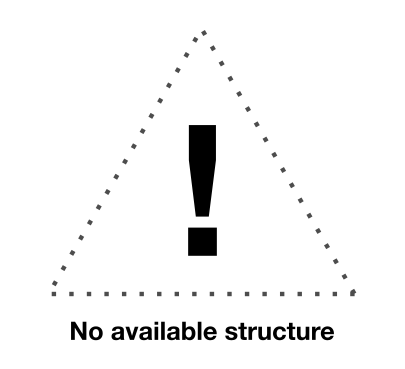P0DKK3
Gene name |
PAC1A (Os06g0176000, LOC_Os06g07878, OsJ_019497, P0015E04.21) |
Protein name |
Proteasome subunit alpha type-4-1 |
Names |
20S proteasome alpha subunit C , 20S proteasome subunit alpha-3 |
Species |
Oryza sativa subsp. japonica (Rice) |
KEGG Pathway |
osa:107278560, osa:4340285, |
EC number |
|
Protein Class |
|

Descriptions
Autoinhibitory domains (AIDs)
Target domain |
29-215 (Central channel of proteasome) |
Relief mechanism |
Partner binding |
Assay |
|
Accessory elements
No accessory elements
References
- Groll M et al. (2000) "A gated channel into the proteasome core particle", Nature structural biology, 7, 1062-7
- Köhler A et al. (2001) "The substrate translocation channel of the proteasome", Biochimie, 83, 325-32
- Polyakov KM et al. (2002) "The structure of substrate-free microbial ribonuclease binase and of its complexes with 3'GMP and sulfate ions", Acta crystallographica. Section D, Biological crystallography, 58, 744-50
Autoinhibited structure

Activated structure

1 structures for P0DKK3
| Entry ID | Method | Resolution | Chain | Position | Source |
|---|---|---|---|---|---|
| AF-P0DKK3-F1 | Predicted | AlphaFoldDB |
No variants for P0DKK3
| Variant ID(s) | Position | Change | Description | Diseaes Association | Provenance |
|---|---|---|---|---|---|
| No variants for P0DKK3 | |||||
No associated diseases with P0DKK3
1 regional properties for P0DKK3
| Type | Name | Position | InterPro Accession |
|---|---|---|---|
| domain | Proteasome alpha-subunit, N-terminal domain | 5 - 27 | IPR000426 |
3 GO annotations of cellular component
| Name | Definition |
|---|---|
| cytosol | The part of the cytoplasm that does not contain organelles but which does contain other particulate matter, such as protein complexes. |
| nucleus | A membrane-bounded organelle of eukaryotic cells in which chromosomes are housed and replicated. In most cells, the nucleus contains all of the cell's chromosomes except the organellar chromosomes, and is the site of RNA synthesis and processing. In some species, or in specialized cell types, RNA metabolism or DNA replication may be absent. |
| proteasome core complex, alpha-subunit complex | The proteasome core subcomplex that constitutes the two outer rings of the proteasome core complex. An example of this component is found in Mus musculus. |
No GO annotations of molecular function
| Name | Definition |
|---|---|
| No GO annotations for molecular function |
1 GO annotations of biological process
| Name | Definition |
|---|---|
| proteasome-mediated ubiquitin-dependent protein catabolic process | The chemical reactions and pathways resulting in the breakdown of a protein or peptide by hydrolysis of its peptide bonds, initiated by the covalent attachment of ubiquitin, and mediated by the proteasome. |
11 homologous proteins in AiPD
| UniProt AC | Gene Name | Protein Name | Species | Evidence Code |
|---|---|---|---|---|
| P23638 | PRE9 | Proteasome subunit alpha type-3 | Saccharomyces cerevisiae (strain ATCC 204508 / S288c) (Baker's yeast) | EV |
| Q3ZCK9 | PSMA4 | Proteasome subunit alpha type-4 | Bos taurus (Bovine) | SS |
| P18053 | Prosalpha3 | Proteasome subunit alpha type-4 | Drosophila melanogaster (Fruit fly) | SS |
| Q9VA12 | Prosalpha3T | Proteasome subunit alpha type-4-like | Drosophila melanogaster (Fruit fly) | SS |
| P25789 | PSMA4 | Proteasome subunit alpha type-4 | Homo sapiens (Human) | SS |
| Q9R1P0 | Psma4 | Proteasome subunit alpha type-4 | Mus musculus (Mouse) | SS |
| P21670 | Psma4 | Proteasome subunit alpha type-4 | Rattus norvegicus (Rat) | SS |
| Q5VRG3 | Os06g0167600 | Proteasome subunit alpha type-4-2 | Oryza sativa subsp. japonica (Rice) | SS |
| Q9N599 | pas-3 | Proteasome subunit alpha type-4 | Caenorhabditis elegans | SS |
| F4JJE5 | PAC2 | Putative proteasome subunit alpha type-4-B | Arabidopsis thaliana (Mouse-ear cress) | SS |
| O81148 | PAC1 | Proteasome subunit alpha type-4-A | Arabidopsis thaliana (Mouse-ear cress) | SS |
| 10 | 20 | 30 | 40 | 50 | 60 |
| MSRRYDSRTT | IFSPEGRLYQ | VEYAMEAIGN | AGSALGVLAA | DGVVLVGEKK | VTSKLLQTSR |
| 70 | 80 | 90 | 100 | 110 | 120 |
| SAEKMYKIDS | HLACAVAGIM | SDANILLNTA | RLHAQRYALS | YQEPIPVEQL | VQSLCDTKQG |
| 130 | 140 | 150 | 160 | 170 | 180 |
| YTQFGGLRPF | GVSFLFAGWD | KHHGFQLYMS | DPSGNYSGWK | AAAVGANSQA | AQSMLKQDYR |
| 190 | 200 | 210 | 220 | 230 | 240 |
| DGMTREEAVA | LALKVLSKTM | DSTSLTAEKL | ELAEVFLQPG | TGEVQYQVCS | PEAMGKLLAK |
| AGLSQPAPEA |